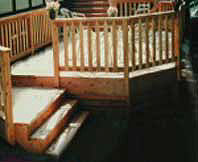Build an IPE Deck
(deck construction-wood ipe/bois ipe)
If you wish to build an Ipe deck some consideration can be
made for the strength characteristics of the ipe lumber  in
the design phase. Ipe has a Janka hardness rating of 3640
making ipe almost 3 times harder than northern Red Oak, so
you can adjust your wood needs to reflect the high degree
of strength associated with all Ipe lumber.
in
the design phase. Ipe has a Janka hardness rating of 3640
making ipe almost 3 times harder than northern Red Oak, so
you can adjust your wood needs to reflect the high degree
of strength associated with all Ipe lumber.
As an example in deck construction using wood like ipe you can often get away with 3/4" top dressing on 16" studding, vs the more traditional full 1" thick or 1 1/2" thick planking. Thus find out what standard sizes of ipe lumber are available, study your deck design and then determine if it is possible to downsize your dimensions.... although keep in mind that visual appeal or local regulations may override your original decisions.
Stock Sizes:
Ipe is typically available in 3/4", 1" and 1 1/2"
thick material. As suggested earlier, the 3/4" thick
material maybe strong enough to replace traditional 1"
& 1 1/2" thick, softwood lumber. You may chose the
full one inch thick hardwood ipe decking planks, to compensate
for a longer joist spacing of 24", or just because you
desire a thicker visual appearance.
That being said, the final say in structural design, rests with your local building controls office or engineer... so make sure that you consult with their inspectors for regulations within your jurisdiction.
Often the wood is rounded or eased on all four edges, so if this is not suitable to your needs, make sure you ask.
Ipe Wood Conditioning:
Ipe Lumber typically comes to you as an air dried product.
It is always recommended to sticker and stack lumber with
access to a good air flow so that it might equalize it moisture
content to the existing environment, prior to construction.
This can take a few months depending on your environment.
Thus if you are thinking to build an ipe deck plan ahead.
Machining:
Ipe wood can be fairly easily cut with standard carbide tipped
blades, but does require predrilling for both nails and screws.
Cobalt Drill bits have been recommended for longer life, especially
if you can find the ones that are designed with an extended
spiral, for easier and faster chip removal. Don't overheat
your blade, or drill bit. This will significantly reduce your
blade's life... let the tool do the work.
Ipe is fairly difficult to plane and mould, and it is recommended that you reduce the cutting angle to approximately 15 degrees, for best results. It is a good thing that in deck construction with a wood like ipe, few mouldings are required.
Note: I have been told that if you are doing steps using pressure treated wood stringers, it is best to use 2 - 2x6 for the treads, rather than 1- 2x12, as the the 2x12 will cup as it dries, and has such power that it may pull out the screws that are holding the treads to the pressure treated wood stringers.
End Finishing:
Quite a number of installers recommend that all end cuts be
sealed shortly after trimming to length, with a latex based
product like anchorseal (a good paraffin based wax emulsion)
end sealer to prevent end checking that is invariable with
an air dried material. The sooner the cross cuts are sealed
after cutting and/or end trimmed, the more effective it will
be.
Spacing between boards:
Typically Ipe comes to you air dried between 16-20% moisture
content. As suggested earlier, it should be allowed to acclimatize
to the installation environment, prior to use, placing it
in an area of air circulation, but out of direct sunlight.
Shrinkage is typically between 1/16-1/8" depending on
the local environment.
Ipe can be butt jointed, but be aware of the expansion/contraction issues at your job site. If you install it in the driest part of your year and then the boards expand in the humid summer months, it could cause undue stress on your screws and floor joists.
Thus most installers that have worked with Ipe decking recommend a gap of between 1/16" and 1/8" between the individual boards. This is to give enough room to allow drainage of surface water.
More Information:
In deck construction with a wood like ipe, what fastening systems are recommended?
